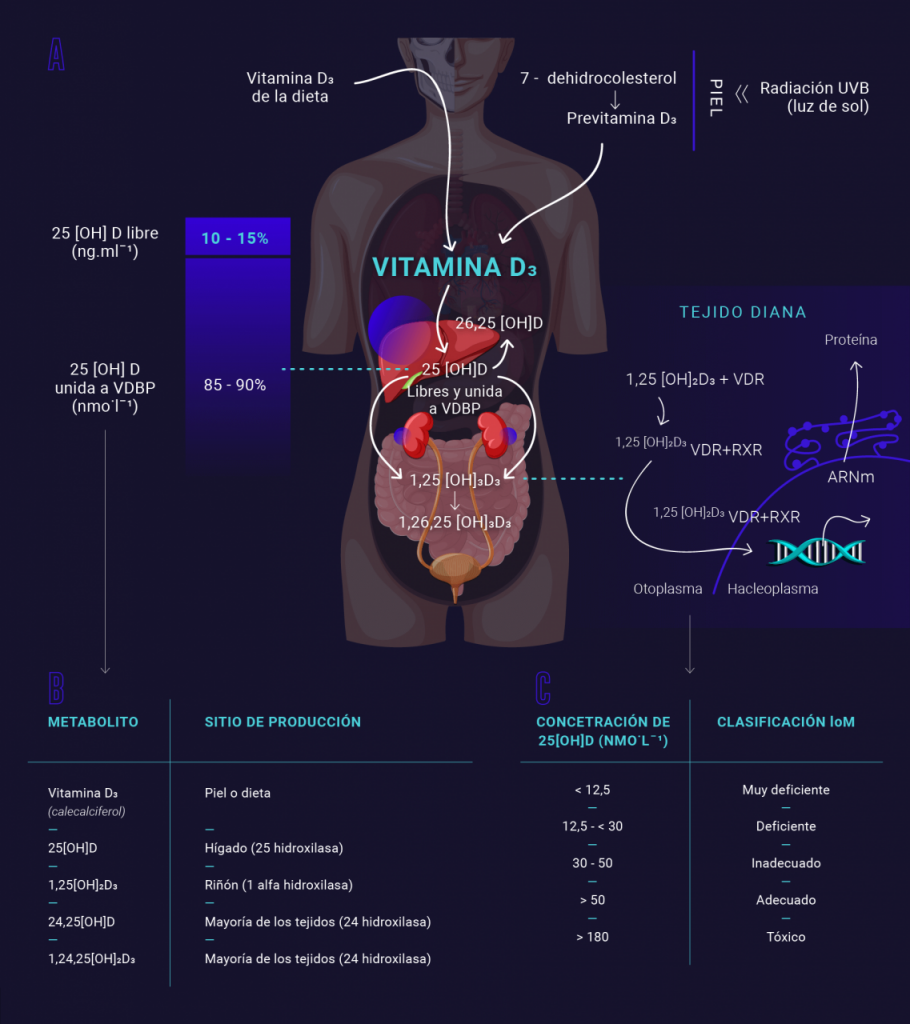Vitamin D: more than previously thought
Vitamin D has been recognized exclusively for its role in bone health. Advances in technology have helped to understand the endocrine system of vitamin D and its biological importance.
Finding a large number of molecular targets in numerous tissues: bone, cells of the immune system, cardiovascular system, and skeletal muscle; has made it possible to understand that the functions of vitamin D cover more than previously thought.
Many of these functions are of great importance in athletic performance , such as optimizing muscle function, maintaining bone health or minimizing muscle risk of infections.
But we cannot speak of vitamin D as an ergogenic aid but rather a biological necessity, therefore individual vitamin D levels must be taken into account before using a supplement.

What is Vitamin D deficiency?
Currently, a deficiency of this vitamin is observed in the general population and among athletes. Some of the reasons have to do with lifestyles that are too “indoors”: working long hours at home or office, training in the gym, etc. But others, less remediable, are related to some seasons of the year or living in countries with higher latitudes.
In the following table C of the image below you can see the adequate levels of vitamin D that are between 100-150 nmol / L.
In ng / mL the appropriate values would be between 40-60.
5 (very poor)
5- 12-20 (inadequate)
> 20 (adequate)
> 72 (toxic)
In UI the ranges of values would be these:
500 (very poor)
500- 1200-2000 (inadequate)
> 2000 (adequate)
> 7200 (toxic)
Why is it important that the Sun gives us?
Vitamin D is synthesized mainly from exposure to ultraviolet B (UVB) radiation that impacts our skin. From 7-dehydrocholesterol that is found pre-vitamin D3 is synthesized in the dermis. This pre-vitamin D3 is transformed into cholecalciferol (Vitamin D3).
The vitamin D that we introduce into the body through food is absorbed directly in the form of cholecalciferol or vitamin D3.
Vitamin D3 needs to undergo two hydroxylations to be transformed into the active form that can exert biological functions in the body. The first hydroxylation occurs in the liver and the second in the kidney.
1,25 (OH) 2D3 binds to its receptors forming a complex that accesses the cell nucleus where it controls the expression of genes that stimulate the synthesis of proteins responsible for regulating different processes.

The problem at the dietary level is that the bioavailability is lower, around 50%. Bioavailability and half-life is greater through the sun. And you will ask yourself, how long do I have to be exposed? That depends on the type of skin, the latitude where you are, the season of the year, the time of day … as you can see there are many variables to take into account.
Foods rich in Vitamin D :
- Fish fatty (salmon, tuna, mackerel)
- Bovine liver
- Cheese
- Yema de egg
- Milk or vegetable drinks fortified in Vit.D
Vitamin D deficiency is related to different processes that can affect health, such as:
- Cancer risk
- Cardiovascular risk
- Insulin resistance
- Neurodegeneration
- Depression
- Inflammation
- Muscle weakness
The latter can greatly affect the performance of athletes since it will promote muscle atrophy, oxidative stress, a decrease in mitochondrial biogenesis and mitochondrial dysfunction. In other words, a weaker muscle and less efficient when using energy substrates.
What functions does vitamin D have in the athlete?
Muscle repair and remodeling
A correct vitamin D status is associated with optimal recovery of strength after intense exercise. It is also associated with a greater recruitment of satellite cells, which allows proper muscle regeneration.
Muscle function
In older populations, an adequate level of vitamin D has been shown to improve the sarcopenic state of the muscle. Vitamin D improves calcium metabolism that is associated with muscle contractions, but it cannot yet be suggested that it plays a role in contractile properties and force-producing capacity in athletes.
Innate and acquired immunity
The vast majority of antibodies have the enzyme 1-alpha hydroxylase that is responsible for making the second hydroxylation that synthesizes the active form of vitamin D. This suggests that vitamin D is important for the immune system .
Structure and function of the heart
The heart and vascular system contain the vitamin D receptor and are capable of synthesizing its active form. A deficit can affect cardiac contractility, vascular tone, cardiac collagen content, or cardiac tissue maturation.
Bone health and risk of fractures
Vitamin D is an indicator of calcium absorption and bone mineralization. There are genetic, environmental, and cultural factors associated with vitamin D deficiency that increase the risk of osteoporosis and fractures.
Vitamin D is responsible for the regulation of osteoclasts and osteoblasts (destroyers and builders of bone) during bone remodeling.
How do you know if you need to use a supplement?
25 (OH) D is the most useful marker to measure vitamin D status as it has a long half-life and is closely related to vitamin D3 exposure (dermal synthesis or dietary intake).

Quarantine tips
- Have an online nutritionist plan and personalize your diet.
- Try to have a minimum of direct exposure to sunlight, it does not have to be the whole body or spend hours.
- If sunbathing through a window does not work, UVB rays are not absorbed (they help to synthesize vitamin D), while UVA they are absorbed and are more related to cell damage and cancer. Beware of overdoing it.
- Dietary vitamin D (ingested in food) has a low availability but it is important that it is present in our diet. Try to take more into account the foods rich in vitamin D that we mentioned in the post.
- Contact your medical center for an analysis when the health alarm situation returns to normal. This will allow to know the vitamin D status and see if it is necessary to supplement.
Conclusions
- A Vitamin D deficiency can directly or indirectly affect the performance of an athlete, therefore it is recommended to monitor individual status.
- Before supplementing, in order to avoid mega doses, it is necessary to know the levels of vitamin D with an analysis. Once the results are known and thanks to the decision tree, it is possible to make a more correct decision.
- Studies confirm that there are no ergogenic benefits in athletes if there is no vitamin D deficiency.
- If you are looking for an online nutritionist who can plan and personalize your nutrition, take a look at our service with online nutritionist
